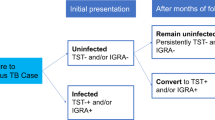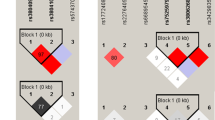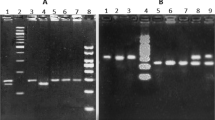Abstract
Toll-like receptors recognize several components of Mycobacterium tuberculosis, the main causative agent of tuberculosis. The signaling pathways leading to activation of the immune response require the MyD88 and TIRAP genes. The hypothesis that polymorphic variants of these genes influenced resistance to pulmonary tuberculosis was tested by a case–control study (400 cases and 400 controls). Heterozygosity at the polymorphic sites MyD88 rs6853 (alleles: A, G) or TIRAP rs8177374 (S180L) (alleles: C, T) is associated with resistance to pulmonary tuberculosis (P: 7.8 × 10−8 and 2 × 10−6, respectively). Double heterozygosity confers higher protection levels (P: 10−14 to 2 × 10−16). The logistic regression model displayed that the double homozygous genotype GG/TT predisposes to the disease (odds ratio (OR): 5.78) and the AG/TT genotype combination neutralizes the protective activity exerted by AG (OR: 3.05). The same model showed that the risk of developing the disease increases with age from 31–40 years to 71–80 years (OR: 1.32–13.59).
This is a preview of subscription content, access via your institution
Access options
Subscribe to this journal
Receive 6 digital issues and online access to articles
$119.00 per year
only $19.83 per issue
Buy this article
- Purchase on Springer Link
- Instant access to full article PDF
Prices may be subject to local taxes which are calculated during checkout




Similar content being viewed by others
References
Doherty TM, Arditi M . TB, or not TB: that is the question—does TLR signaling hold the answer? J Clin Invest 2004; 114: 1699–1703.
Bonnert T, Garka K, Parnet P, Sonada G, Testa J, Sims J . The cloning and characterization of human MyD88: a member of an IL-1 receptor related family. FEBS Lett 1997; 402: 81–84.
Khor CC, Chapman SJ, Vannberg FO, Dunne A, Murphy C, Ling EY et al. A Mal functional variant is associated with protection against invasive pneumococcal disease, bacteremia, malaria and tuberculosis. Nat Genet 2007; 39: 523–528.
Fremond CM, Yeremeev V, Nicolle DM, Jacobs M, Quesniaux VF, Ryffel B . Fatal Mycobacterium tuberculosis infection despite adaptive immune response in the absence of MyD88. J Clin Invest 2004; 114: 1790–1799.
Fremond CM, Togbe D, Doz E, Rose S, Vasseur V, Maillet I et al. IL-1 receptor-mediated signal is an essential component of MyD88-dependent innate response to Mycobacterium tuberculosis infection. J Immunol 2007; 179: 1178–1189.
Hawn TR, Dunstan SJ, Thwaites G, Simmons CP, Thoung NT, Lan NT et al. A polymorphism in Toll-Interleukin 1 receptor domain containing adaptor protein is associated with susceptibility to meningeal tuberculosis. J Infect Dis 2006; 194: 1127–1134.
Caws M, Thwaites G, Dunstan S, Hawn TR, Lan NT, Thoung NT et al. The influence of host and bacterial genotype on the development of disseminated disease with Mycobacterium tuberculosis. PLoS Pathog 2008; 4: e1000034.
Miao R, Sun Z, Xu F, Shen H . Meta-analysis on the association of TIRAP S180L variant and tuberculosis susceptibility. Tuberculosis 2011; 91: 268–272.
Nejentsev S, Thye T, Szeszko J, Stevens H, Balabanova Y, Chinbuah A et al. Analysis of association of the TIRAP (MAL) S180L variant and tuberculosis in three populations. Nat Genet; 40: 261–262.
Sanchez D, Lefebvre C, Rioux J, Garcia L, Barrera L . Evaluation of Toll-like receptor and adaptor molecule polymorphisms for susceptibility to tuberculosis in a Colombian population. Int J Immunogenet 2012; 39: 216–223.
Leung A . Pulmonary tuberculosis: The essential. Radiology 1999; 210: 307–322.
Fitzgerald K, Paisson-McDermott E, Bowle A, Jefferies C, Mansell A, Brady G et al. Mal (MyD88-adapter like) is required to Toll-like receptor-4 signal transduction. Nature 2001; 413: 78–83.
Casanova J, Abel L . Genetic dissection of immunity to mycobacteria: the human model. Annu Rev Immunol 2002; 20: 581–620.
Velez D, Hulme W, Myers J, Weinberg JB, Lévesque MC, Stryiewski LM et al. NOS2A, TLR4, and IFNGR1 interactions influence pulmonary tuberculosis susceptibility in African-Americans. Hum Genet 2009; 126: 643–653.
Fortune S, Solache A, Jaeger A, Hill PJ, Belisle JT, Bloom BR et al. Mycobacterium tuberculosis inhibits macrophage responses to IFN-γ through myeloid differentiation factor 88-dependent and -independent mechanisms. J Immunol 2004; 172: 6272–6280.
Scanga C, Bafica A, Feng C, Cheever A, Hieny S, Sher A . MyD-88 deficient mice display a profound loss in resistance to Mycobacterium tuberculosis associated with partially impaired Th1 cytokine and nitric oxide synthase 2 expression. Infect Immun 2004; 72: 2400–2404.
Miller E, Ernst J, Anti. TNF . immunotherapy and tuberculosis reactivation: another mechanism revealed. J Clin Invest 2009; 119: 1079–1082.
Glickman M, Jacobs W Jr. . Microbial pathogenesis of Mycobacterium tuberculosis: dawn of a discipline. Cell 2001; 104: 477–485.
Mankia S, Peters J, Kang S, Moore S, Ehrenstein M . Tuberculosis and anti-TNF treatment: experience of a central London hospital. Clin Rheumatol 2011; 30: 399–401.
French M, Lenzo N, John M, Mallal SA, McKinnon EJ, James IR et al. Immune restoration disease after treatment of immunodeficient HIV-infected patients with highly active antiretroviral therapy. HIV Medicine 2001; 1: 107–115.
Anonymous. Freely associating. Nat Genet 1999; 22: 1–2.
Ioannidis J, Ntzani E, Trikalinos T, Contopoulos-Ioannidis D . Replication validity of genetic association studies. Nat Genet 2001; 29: 306–309.
Nacham M, Crowell S . Estimate of the mutation rate per nucleotide in human. Genetics 2009; 156: 297–304.
McKerman K, Peckam H, Costa L, McLaughlin S, Fu Y, Tsung E et al. Sequence and structural variation in a human genome uncovered by short-read, massively parallel ligation sequencing using two-base encoding. Genome Res 2009; 19: 1527–1541.
Schurr E . Is susceptibility to tuberculosis acquired or inherited? J Intern Med 2007; 261: 106–111.
McClellan J, King M-C . Genetic heterogeneity in human disease. Cell 2010; 141: 210–217.
Anonymous. Reducing our irreproducibility. Nature 2013; 496: 398.
Anonymous. Further confirmation needed. Nat Biotech 2012; 30: 806.
Lohmueller K, Celeste R, Malcolm P, Lander E, Hirschhorn J . Meta-analysis of genetic association studies supports a contribution of common variants to susceptibility to common disease. Nat Genet 2003; 33: 177–182.
Sambrook J, Fritsch EF, Maniatis T . Molecular Cloning vol I Cold Spring Harbor Laboratory, 1989, pp 5–50.
Garret K, Madden L, Hughes G, Phender W . New applications of statistical tools in plant pathology. Phytopathology 2004; 94: 999–1003.
Kumar P, Henikoff S, Ng PC . Predicting the effects of coding non-synonymous variants on protein function using the SIFT algorithm. Nat Protoc 2009; 4: 1073–1081.
Roy A, Kucukural A, Zhang Y . I-TASSER: a unified platform for automated protein structure and function prediction. Nat Protoc 2010; 5: 725–738.
Acknowledgements
We thank patients and their families for participation in the study. We also thank an anonymous reviewer for insightful suggestions.
Author information
Authors and Affiliations
Corresponding author
Ethics declarations
Competing interests
The authors declare no conflict of interest.
Rights and permissions
About this article
Cite this article
Capparelli, R., De Chiara, F., Di Matteo, A. et al. The MyD88 rs6853 and TIRAP rs8177374 polymorphic sites are associated with resistance to human pulmonary tuberculosis. Genes Immun 14, 504–511 (2013). https://doi.org/10.1038/gene.2013.48
Received:
Revised:
Accepted:
Published:
Issue Date:
DOI: https://doi.org/10.1038/gene.2013.48
Keywords
This article is cited by
-
Pathogen recognition pathway gene variants and inflammasome sensors gene expression in tuberculosis patients under treatment
Molecular Biology Reports (2024)
-
Is there an Inflammation Role for MYD88 in Rheumatoid Arthritis?
Inflammation (2021)
-
MyD88 in Mycobacterium tuberculosis infection
Medical Microbiology and Immunology (2017)



